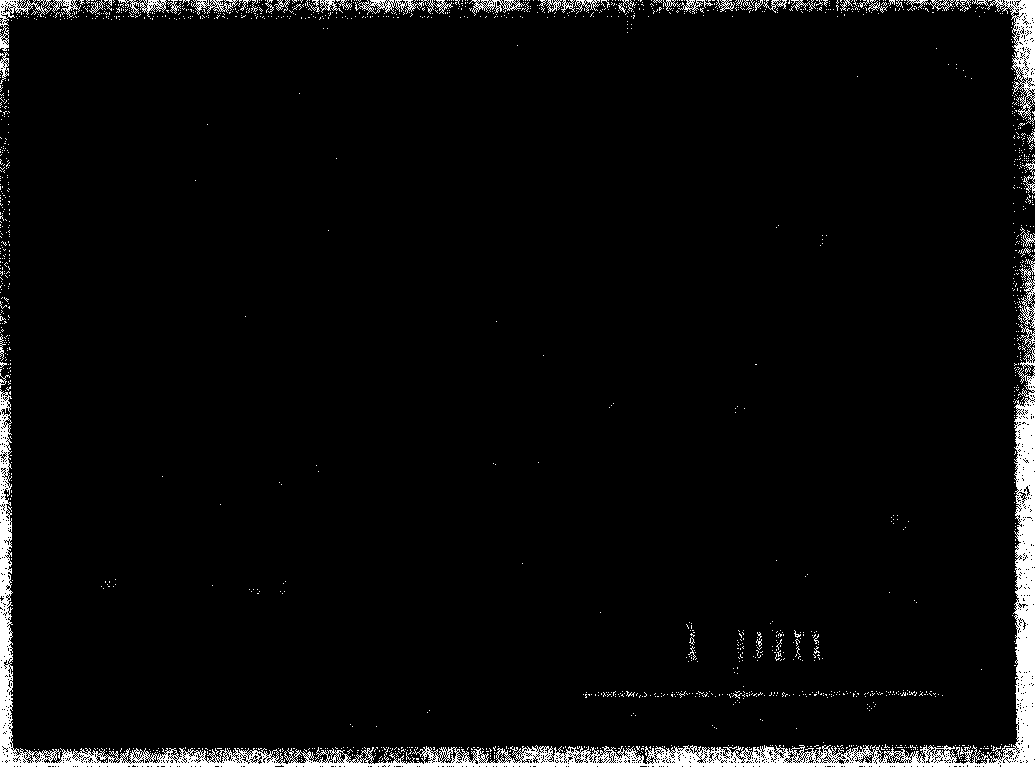Method for manufacturing photoelectrocatalysis double-function electrode with wide wave range response
A photocatalytic, bifunctional technology, applied in the field of material chemistry, can solve the problems of narrow spectral response range, difficult photocatalytic activity, and insufficient dispersion, and achieve stable electrocatalytic performance, improved photocatalytic performance, and high oxygen evolution potential. Effect
- Summary
- Abstract
- Description
- Claims
- Application Information
AI Technical Summary
Problems solved by technology
Method used
Image
Examples
Embodiment 1
[0031] Prepare 0.01mol / L CdCl 2 and 0.01mol / L Na 2 For the precursor solution of S, a trisiloxane surfactant is added thereto in an amount of 0.5‰ of the total volume of the solution. Using the vacuum infusion method, TiO with a diameter of 50 nm and a thickness of 1 μm 2 Nanotubes filled with 0.05mol / L CdCl 2 and 0.05mol / L Na 2 S precursor solution, after repeating 3 times, the nanotubes were immersed in the two solutions respectively, and the immersion time was 30s each time. After each removal, the surface solution was wiped dry, and the process was repeated 15 times.
[0032] 10gSnCl 4 ·5H 2 O was dissolved in 50 mL of absolute ethanol containing 5 mL of concentrated hydrochloric acid, stirred thoroughly until clear, and then 0.5 g of SbCl was added 3 , fully stirred until clear, and placed in a dark place for 8 hours to obtain SnCl 4 ·5H 2 O and SbCl 3 Tin-antimony sol with a mass ratio of 20:1. in TiO 2 One side of the NTs / CdS was coated with tin-antimony sol...
Embodiment 2
[0035] Prepare 0.05mol / L CdCl 2 and 0.05mol / L Na 2 For the precursor solution of S, a trisiloxane surfactant is added thereto in an amount of 0.8‰ of the total volume of the solution. Using the vacuum infusion method, TiO with a diameter of 60 nm and a thickness of 1 μm 2 The nanotubes were respectively loaded with two kinds of precursor solutions. After repeating 3 times, the nanotubes were immersed in the two solutions respectively. The soaking time was 30s each time. After each removal, the surface solution was wiped dry, and the process was repeated 15 times.
[0036] 7.5gSnCl 4 ·5H 2 O was dissolved in 75 mL of absolute ethanol containing 7.5 mL of concentrated hydrochloric acid, stirred thoroughly until clear, and then 0.5 g of SbCl was added 3 , fully stirred until clarified, and placed in a dark place for precipitation for 12 hours to obtain SnCl 4 ·5H 2 O and SbCl 3 Tin-antimony sol with a mass ratio of 15:1. in TiO 2 One side of NTs / CdS was coated with tin-...
Embodiment 3
[0038] Prepare 0.05mol / L CdCl 2 and 0.05mol / L Na 2 For the precursor solution of S, add trisiloxane surfactant to it, and the added amount is 1‰ of the total volume of the solution. Using the vacuum infusion method, TiO with a diameter of 80 nm and a thickness of 2 μm 2 The nanotubes were respectively loaded with two kinds of precursor solutions. After repeating 3 times, the nanotubes were immersed in the two solutions respectively. The soaking time was 30s each time. After each removal, the surface solution was wiped dry, and the process was repeated 15 times.
[0039] 5gSnCl 4 ·5H 2 O was dissolved in 100 mL of absolute ethanol containing 10 mL of concentrated hydrochloric acid, stirred thoroughly until clear, and then 0.5 g of SbCl was added 3 , fully stirred until clear, and placed in a dark place for 16 hours to obtain SnCl 4 ·5H 2 O and SbCl 3 A tin-antimony sol with a concentration ratio of 10:1. in TiO 2 One side of the NTs / CdS was coated with tin-antimony so...
PUM
| Property | Measurement | Unit |
|---|---|---|
| diameter | aaaaa | aaaaa |
| thickness | aaaaa | aaaaa |
| diameter | aaaaa | aaaaa |
Abstract
Description
Claims
Application Information
 Login to View More
Login to View More - R&D
- Intellectual Property
- Life Sciences
- Materials
- Tech Scout
- Unparalleled Data Quality
- Higher Quality Content
- 60% Fewer Hallucinations
Browse by: Latest US Patents, China's latest patents, Technical Efficacy Thesaurus, Application Domain, Technology Topic, Popular Technical Reports.
© 2025 PatSnap. All rights reserved.Legal|Privacy policy|Modern Slavery Act Transparency Statement|Sitemap|About US| Contact US: help@patsnap.com



